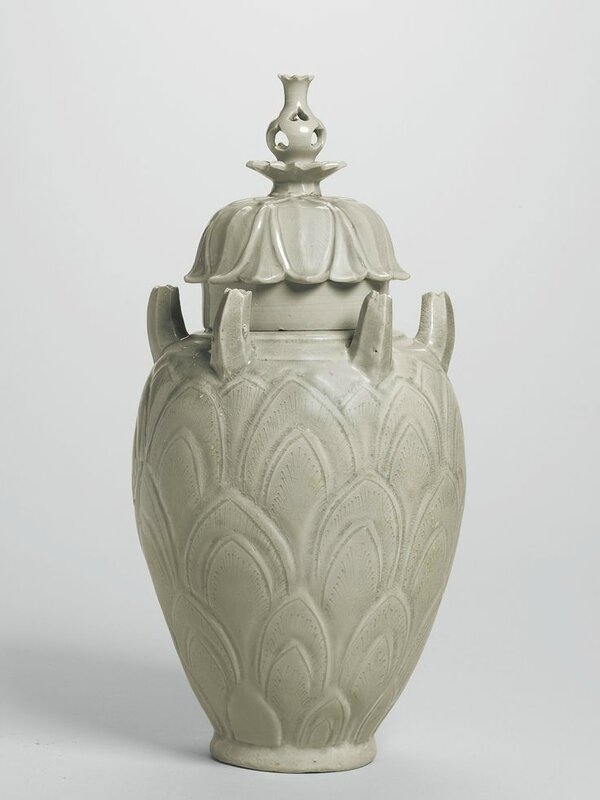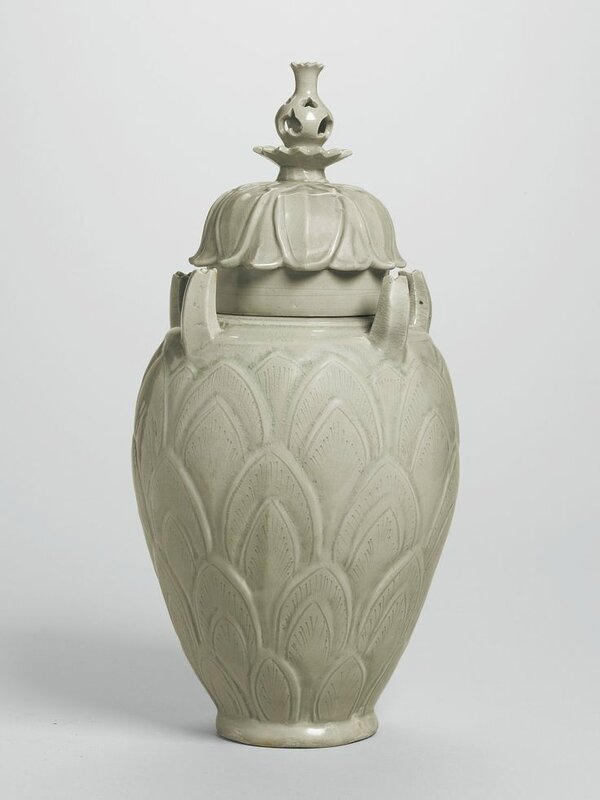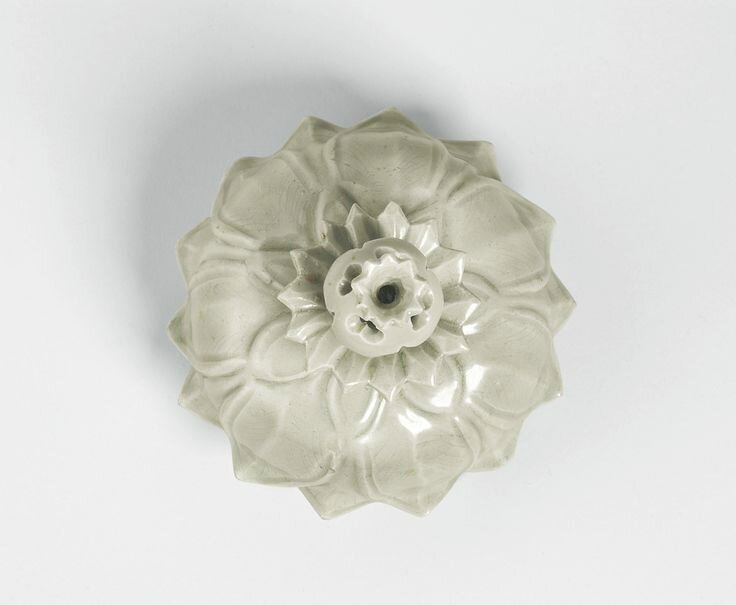A celadon 'Grain' jar and cover, Five Dynasties - Northern Song dynasty
Lot 65. A celadon 'Grain' jar and cover, Five Dynasties - Northern Song dynasty. Estimate 500,000 — 700,000 USD. Unsold. Photo Sotheby's.
the shouldered ovoid body tapering to a splayed foot, set on the shoulders with five evenly spaced spouts with serrated tips and slightly incurved towards the cylindrical neck, the body carved with rows of lotus petals diminishing in size near the base, the high domed cover carved in high relief with pendent overlapping lotus petals surmounted by a pierced lotus bud finial, covered overall with a thin gray-green glaze (2). Height 14 1/4 in., 36.2 cm
Notes: This magnificent grain jar, of superlative quality and possessing its original cover is a very rare and early example of a short-lived tradition of vessels made by the Longquan kilns in Zhejiang province to secure eternal well-being of a family. Five-spouted jars were usually accompanied by dish-mouthed vases to hold grains and liquor. Although both these jars and vases were often placed in tombs, they were also given as gifts to the elderly in the hope that they would pray for their descendants while still alive and thus ensure the well-being of their family in the afterlife.
A five-spouted jar in the Museum Yamato Bunkakan, Nara, is incised with an inscription that states that it was presented to Granny He for longevity and happiness in life, and for blessing her descendants after death, see Chinese Ceramics from the Museum Yamato Bunkakan Collection, Illustrated Catalogue Series No. 7, Nara, 1977, pl. 48. A dish-mouthed vase in the Sir Percival David Collection of the British Museum is incised with a very similar inscription stating that “This Top Grade vessel is fired to contain liquor of everlasting fragrance. May the owner after death bless the countless descendants with eternal wealth, status, longevity, auspiciousness, infinite happiness and peace for the world”, see Jessica Harrison-Hall, Whose line is it anyway? Marks and Inscriptions on Chinese Ceramics in the Sir Percival David Collection, Orientations, November/December 2009, fig. 9 . The two vessels were both inscribed on the full moon day of the ninth month of the year 1080 and may have been made for the same person for the Mid-Autumn Festival. The primary decoration of lotus petals and a lotus bud on top suggest that this custom was firmly anchored in Buddhist beliefs.
The five spouts may symbolize the proverbial five types of grain, as in the local dialect the term for the tubular spouts (guan管) is homophonous to that for “grain”. A five-spouted jar in the Longquan Celadon Museum, illustrated in Zhu Boqian, ed., Celadons from Longquan Kilns, Taipei, 1998, pl. 56, bears an ink inscription inside the cover that names the vessel expressly a “granary for five types of grain”, which “conforms to the Heaven above and the Earth below and will bless the descendants with long life, wealth and status”.
Longquan in southwestern Zhejiang province was one of China’s major ceramic centers and the predominant producer of celadon wares, comparable in global significance to Jingdezhen, China’s ‘porcelain capital’. From the 11th to 16th centuries Longquan supplied large quantities of ceramics to the domestic and global markets including the Chinese royal court. Grain jars like the present piece with tubular sockets on the shoulder, which typically do not connect to the inside, were primarily made in the 11th century and are unique to the kilns of Longquan. At this early period, the Longquan kilns were still strongly influenced by the exquisite celadons of the Yue kilns further north in the same province, which they soon, however, eclipsed. Jars such as the present piece were formerly often attributed to the Yue kilns, but archaeological evidence from kiln sites and tombs suggests that they were produced by manufactories of the Longquan region.
The present piece with its elegant meiping-like shape and elaborate and beautiful relief decoration, particularly the cover with curled lotus petals and bud, belongs to a very rare type, characterized by particularly fine workmanship. Comparable examples include one unearthed from a tomb in Longquan city, published in Zhongguo chutu ciqi quanji / Complete Collection of Ceramic Art Unearthed in China, Beijing, 2008, vol. 9, pl. 173; one illustrated in Regina Krahl, Chinese Ceramics from the Meiyintang Collection, London 1994-2010, vol. 3, pt. II, no. 1565; one from the Ataka collection in the Museum of Oriental Ceramics, Osaka, included in the exhibition Longquan Ware: Chinese Celadon Beloved of the Japanese, Aichi Prefecture Museum of Ceramics, Aichi, 2012, cat. no. 1; and one included in the Oriental Ceramic Society exhibition The Arts of the T’ang Dynasty, London, 1955, cat. no. 247, illustrated in Margaret Medley, The Chinese Potter, Oxford, 1976, fig. 67, and sold in our London rooms, 29th March 1977, lot 126.
Longquan celadon vase excavated at Duntou village, Longquan city, illustrated in , Beijing, 2008, vol.9, pl. 173. Image © Science Press, 2008
A celadon 'Grain' jar and cover, Five Dynasties - Northern Song dynasty. Image courtesy of Regina Krahl, Chinese Ceramics from the Meiyintang Collection, London. 1994-2010, vol. 3, no. 1565.
Sotheby's. Song Tradition: Early Ceramics from the Yang De Tang Collection. New York, 17 mars 2015, 11:00 AM

/https%3A%2F%2Fprofilepics.canalblog.com%2Fprofilepics%2F1%2F0%2F100183.jpg)
/https%3A%2F%2Fstorage.canalblog.com%2F03%2F02%2F119589%2F96711876_o.jpg)
/https%3A%2F%2Fstorage.canalblog.com%2F11%2F31%2F119589%2F94773502_o.jpg)
/https%3A%2F%2Fstorage.canalblog.com%2F20%2F83%2F119589%2F94772815_o.jpg)
/https%3A%2F%2Fstorage.canalblog.com%2F26%2F72%2F119589%2F75604929_o.jpg)
/https%3A%2F%2Fstorage.canalblog.com%2F59%2F60%2F119589%2F26458628_o.jpg)









/http%3A%2F%2Fstorage.canalblog.com%2F92%2F04%2F119589%2F129776898_o.jpg)
/http%3A%2F%2Fstorage.canalblog.com%2F34%2F95%2F119589%2F129416822_o.jpg)
/http%3A%2F%2Fstorage.canalblog.com%2F30%2F92%2F119589%2F129052833_o.png)
/http%3A%2F%2Fstorage.canalblog.com%2F39%2F41%2F119589%2F129048609_o.png)